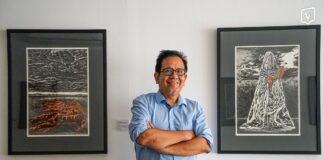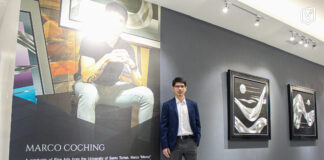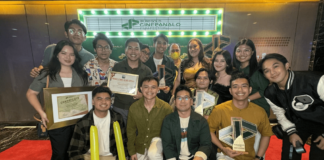Mining the hidden gold in music
My mom once told me that my first awareness of music had dated back more or less four weeks before my expected date of delivery. Mom could not understand why she was gasping for breath when lying flat in bed. She said I was “relentlessly” moving and squirming inside her womb. My eight-year-old sister, who by then already knew how to play the guitar, got her favorite instrument and sat by her side to sing for mom the latter’s favorite piece, in order to console her and lull her to sleep. When my sister was about to sing she accidentally strummed her guitar. Its sound amazingly calmed the baby down inside her womb and pretty soon, she fell asleep.
Giving glamour to glass
 GLASS was generally considered as merely “decorative” until Thomasian sculptor Ramon Orlina came, got his hands on some discarded fragments, and turned it into a new artistic medium.
GLASS was generally considered as merely “decorative” until Thomasian sculptor Ramon Orlina came, got his hands on some discarded fragments, and turned it into a new artistic medium.
In his exhibit titled Glass and Bronze held last June 18 at the Alliance Francaise de Manille, Orlina celebrated more than three decades of upholding the luster and value of glass.
“Glass is a very strong material. Before, people only used it for decoration, but I was able to evolve it into an art form,” Orlina told the Varsitarian.
A College of Architecture and Fine Arts graduate in 1965, Orlina moved into greater heights during the mid-70s by becoming the only sculptor in the Philippines and in the whole ASEAN region to successfully apply the cold method of glass sculpting, a process which virtually eliminates cracks.
“Studying Architecture in UST gave me a discipline, from finishing my work on time and dedicating myself to my craft,” Orlina said.
Revamping ethnic heritage
 THE INTRICATE designs used by the Maranaos in their arts and crafts have been interpreted with the skillful use of acrylic by Thomasian Jane Arrieta-Ebarle in her one-woman exhibit entitled Pinagmulan and running from July 4 to August 1 at the UST Museum.
THE INTRICATE designs used by the Maranaos in their arts and crafts have been interpreted with the skillful use of acrylic by Thomasian Jane Arrieta-Ebarle in her one-woman exhibit entitled Pinagmulan and running from July 4 to August 1 at the UST Museum.
The exhibit is a follow-up on her previous one last year, which also featured ethnic patterns from the tribes of Kalinga, Tausug, Manobo, Bontoc and Maranao. This time, Pinagmulan showcases solely indigenous designs of the Maranaos.
“I thought it would be nice to highlight the ethnic designs by adapting each as theme of my future exhibits,” Ebarle said.
Aside from the ethnic theme, Ebarle also tried different designs, such as the “woman’s form” (dancers in the middle of a movement and women in repose). But she admitted particular fondness with the indigenous design.
A voice with vision
 THIS Thomasian wonder is singing for a good cause.
THIS Thomasian wonder is singing for a good cause.
Reymond Sajor draws on the power of songs in his one-night-only charity concert I’ll Be There… A World Vision Concert last June 27 at the Music Museum.
Organized by World Vision, an international organization dedicated to aiding impoverished children, the concert featured songs by Sajor, all meant to uplift the morale of the Filipino out-of-school youth.
“This organization made me realize that I can help these children, so I got on the stage and sang,” Sajor told the Varsitarian.
Sajor opened with his own rendition of the song “Bawat Bata,” which encompassed the objectives of World Vision to alleviate poverty.
Guest performers The Company outshone the main act with their famous a capella performance of various Filipino songs such as “Tong, tong, tong” and “Abuchikik” mixed with their notorious comical antics.
An artistic homecoming
 AS THE University prepares for its 400th-year milestone, a group of alumni decided to honor their alma-mater with an invaluable gift: rekindled school spirit.
AS THE University prepares for its 400th-year milestone, a group of alumni decided to honor their alma-mater with an invaluable gift: rekindled school spirit.
The UST Atelier Alumni Association, composed of College of Architecture and Fine Arts graduates (CAFA), attempts to rally the Thomasian alumni in time for the 2011 festivities through “Artistang Tomasino Ako!”, a series of quarterly exhibits which started last month.
“This is to make our graduates feel proud,” curator Maryann Venturina-Bulandi said. “People tend to forget where they came from after graduation, we have to unite Thomasians befor the quadricentennial celebration.”
History on the silver screen
 REMEMBER Baler.
REMEMBER Baler.
In commemoration of the Spanish-Filipino Day, the Instituto Cervantes organized a public viewing last June 27 of the film Los Ultimos de Filipinas (1945), which portrayed the events of the “Siege of Baler.”
Often obscured in the pages of history, the “Siege of Baler” was first immortalized on screen during the reign of General Francisco Franco, Spain’s authoritarian leader from 1936 to 1975.
Directed by Antonio Roman, the film retold the experience of the Spanish soldiers trapped inside the church, until the day they surrendered to the Filipinos. It was a story of courage, confusion, and hope, with a tinge of humor.
UST’s environmental dozen
TWELVE artists of different philosophies and artistic styles were brought together by their environmental advocacy in Our Mother’s Boiling Point, which ran recently at the Lunduyan Art Gallery in Quezon City.
Zeus Bascon, JL Burgos, Con Cabrera, Leo Castillo, Mideo Cruz, Arthur dela Cruz, Mariuz Funtillar, Milmal Onal, Marga Rodriguez, Dicky Joe Santos, Katrina Tan and Felix Petel Jr., all graduates of UST, showed works that generally depicted nature’s degradation due to pollution and exploitation.
Mariuz Funtilla, a Fine Arts in Painting graduate, used cigarettes and other smoking paraphernalia in a mixed-media work, “Hindi Ka Pa Ba Naiinitan?”
“It’s ironic that everything that I put in the work destroys the ozone layer, but this art work tells its audience to stop (from smoking),” Funtillar told the Varsitarian.
Painting the town GREEN
MANY Filipinos who experience traffic jams, knee-deep floods and crater-riddled streets share the dream of rebuilding Metro Manila.
Now, they can give their recommendations on how to rehabilitate the metropolis through an online suggestion box spearheaded by street artist Mark Salvatus.
“I’ve lived in the city most of my life,” Salvatus said. “I have experienced the chaos of Metro Manila, and as an artist, I want to improve city life.”
Salvatus, a UST Fine Arts alumni, launched last February the Neo-Urban Planner, as part of his residency at the Green Papaya Art Projects, an artist-run space in Kamuning, Quezon City.
Salvatus started his Neo-Urban Planner endeavor through his blogspot account, where he posted a blog entry asking readers what they would like to change the most in their environment.
The artist said he posted questions such as, ‘If you were Bayani Fernando as the head of the MMDA, what do you want to change about our city?”
Philippine TV recycles the recycled
STARVED for creative ideas – and ideas that work (read: make money), Philippine television has not only recycled old materials, it has also recycled the recycled. Now there’s a new trend: remake of remakes.
Hole in the Wall can make people laugh, but this is still another nail in the coffin of GMA 7 where, it seems, originality is a corpse.
GMA7’s late-afternoon treat provides audiences with excitement and hard laughs through an unusual yet amusing concept for a television game show that had originally come from Japan but which was later ripped off for the US and Indian TV screens.
The poet of small things
TELLING a story vividly is one thing, and writing in verses is another. Yet once in a while, a person comes along who manages to weave both into his writing, and seems to make it look effortless.
In his debut collection, Chiaroscuro (UST Publishing House, 2008), poet Joel Toledo takes his readers on a tour of life—from the forces of nature to the complexities of human existence. The collection’s second and third sections, “What Little I Know of Luminosity” and “Literature and Other Poems,” won him first and second prizes in the Palanca awards for Poetry in English in 2005 and 2004, respectively. He also won second prize in the 2006 Bridport Prize, a British award.












